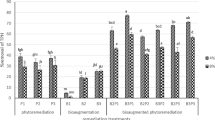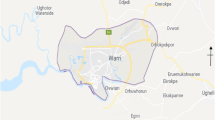Abstract
Many petroleum extraction and refinement plants are located in arid climates. Therefore, the remediation of petroleum-polluted soils is complicated by the low moisture conditions. We ran a 70-day experiment to test the efficacy of various combining of remediation treatments with sorghum, yellow medick, and biochar to remove petroleum from and change the biological activity of Kastanozem, a soil typical of the dry steppes and semideserts of the temperate zone. At normal moisture, the maximum petroleum-degradation rate (40%) was obtained with sorghum–biochar. At low moisture, the petroleum-degradation rate was 22 and 30% with yellow medick alone and with yellow medick − sorghum, respectively. Biochar and the biochar-plant interaction had little effect on soil remediation. Both plants promoted the numbers of soil microbes in their rhizosphere: yellow medick promoted mostly hydrocarbon-oxidizing microorganisms, whereas sorghum promoted both hydrocarbon-oxidizing and total heterotrophic microorganisms. Low moisture did not limit microbial development. In the rhizosphere of sorghum, dehydrogenase and urease activities were maximal at normal moisture, whereas in the rhizosphere of yellow medick, they were maximal at low moisture. Peroxidase activity was promoted by the plants in unpolluted soil and was close to the control values in polluted soil. Biochar and the biochar-plant interaction did not noticeably affect the biological activity of the soil.






Similar content being viewed by others
Data availability
Dataset used in the study can be obtained by a reasonable request from the corresponding author Dr. Ekaterina Dubrovskaya.
Abbreviations
- CHMs:
-
Culturable heterotrophic microorganisms
- HOMs:
-
Hydrocarbon-oxidizing microorganisms
- CFU:
-
Colony-forming units
- UA:
-
Soil urease activity
- DA:
-
Soil dehydrogenase activity
- PA:
-
Soil peroxidase activity
- S:
-
Sorghum
- A:
-
Yellow medick
- O:
-
Petroleum pollution
- M:
-
Normal moisture
- D:
-
Low moisture (drought conditions)
- B:
-
Biochar
- C:
-
Untreated control soil
References
Achuba FI, Okoh PN (2014) Effect of petroleum products on soil catalase and dehydrogenase activities. Open J Soil Sci 4:399–406. https://doi.org/10.4236/ojss.2014.412040
Adetunji AT, Lewu FB, Mulidzi R, Ncube B (2017) The biological activities of β-glucosidase, phosphatase and urease as soil quality indicators: a review. J Soil Sci Plant Nutr 17:794–807. https://doi.org/10.4067/S0718-95162017000300018
Alrumman SA, Standing DB, Paton GI (2015) Effects of hydrocarbon contamination on soil microbial community and enzyme activity. J King Saud Univ Sci 27:31–41. https://doi.org/10.1016/j.jksus.2014.10.001
Anyika C, Majid ZA, Ibrahim Z, Zakaria MP, Yahya A (2015) The impact of biochars on sorption and biodegradation of polycyclic aromatic hydrocarbons in soils—a review. Environ Sci Pollut Res 22:3314–3341. https://doi.org/10.1007/s11356-014-3719-5
Asiabadi FI, Mirbagheri SA, Najafi P, Moatar F (2014) Phytoremediation of petroleum-contaminated soils around isfahan oil refinery (Iran) by sorghum and barley. Curr World Environ 9:65–72. https://doi.org/10.12944/CWE.9.1.10
Bailey VL, Fansler SJ, Smith JL, Bolton JH (2011) Reconciling apparent variability in effects of biochar amendment on soil enzyme activities by assay optimization. Soil Biol Biochem 43:296–301. https://doi.org/10.1016/j.soilbio.2010.10.014
Banks MK, Kulakow P, Schwab AP, Chen Z, Rathbone K (2003) Degradation of crude oil in the rhizosphere of Sorghum bicolor. Int J Phytorem 5:225–234. https://doi.org/10.1080/16226510390255670
Barati M, Bakhtiari F, Mowla D, Safarzadeh S (2017) Total petroleum hydrocarbon degradation in contaminated soil as affected by plants growth and biochar. Environ Earth Sc 76:688. https://doi.org/10.1007/s12665-017-7017-7
Bartha R, Bordeleau L (1969) Cell-free peroxidases in soil. Soil Biol Biochem 1(2):139–143. https://doi.org/10.1016/0038-0717(69)90004-2
Bogati K, Walczak M (2022) The impact of drought stress on soil microbial community, enzyme activities and plants. Agronomy 12:189. https://doi.org/10.3390/agronomy12010189
Cao Y, Yang B, Song Z, Wang H, He F, Han X (2016) Wheat straw biochar amendments on the removal of polycyclic aromatic hydrocarbons (pahs) in contaminated soil. Ecotoxicol Environ Saf 130:248–255. https://doi.org/10.1016/j.ecoenv.2016.04.033
Das N, Chandran P (2011) Microbial degradation of petroleum hydrocarbon contaminants: an overview. Biotechnol Res In ID 941810.https://doi.org/10.4061/2011/941810
Dike CC, El S, Surapaneni A, Shah K, Ball AS (2021) Can biochar be an effective and reliable biostimulating agent for the remediation of hydrocarbon-contaminated soils? Environ Int 154:e106553. https://doi.org/10.1016/j.envint.2021.106553
Drugov YuS, Rodin AA (2007) Opredeleniye nefteproduktov v pochve i donnykh otlozheniyakh. In: Ekologicheskiye analizy pri razlivah nefti i nefteproduktov. Prakticheskoye rukovodstvo (Detection of oil products in soil and bottom sediments. In: Environmental analyzes during oil spills and oil products. Practical guidance). BINOM, Moscow, pp 167–217 (in Russian)
Epifanova IV, Timoshkin OA (2018) Otsenka obraztsov lyutserny na zasukhoustoychivost' v usloviyakh Srednego Povolzh'ya (Assessment of alfalfa samples for drought resistance in the conditions of the Middle Volga region). Mezhdunarodnyy sel'skokhozyaystvennyy zhurnal (International Agricultural Journal) 4:48–51. https://doi.org/10.24411/2587-6740-2018-14062
Foster EJ, Fogle EJ, Cotrufo MF (2018) Sorption to biochar impacts β-glucosidase and phosphatase enzyme activities. Agriculture 8:e158. https://doi.org/10.3390/agriculture8100158
Galitskaya P, Akhmetzyanova L, Selivanovskaya S (2016) Biochar-carrying hydrocarbon decomposers promote degradation during the early stage of bioremediation. Biogeosciences 13:5739–5752. https://doi.org/10.5194/bg-13-5739-2016
Hall J, Soole K, Benham R (2011) Hydrocarbon phytoremediation in the family Fabaceae — a review. Int J Phytoremediation 13:317–332. https://doi.org/10.1080/15226514.2010.495143
Han T, Zhao Z, Bartlam M, Wang Y (2016) Combination of biochar amendment and phytoremediation for hydrocarbon removal in petroleum-contaminated soil. Environ Sci Pollut Res 23:21219–21228. https://doi.org/10.1007/s11356-016-7236-6
Hedo de Santiago J, Lucas-Borja ME, Wic-Baena C, Andrés-Abellán M, de las Heras J (2016) Effects of thinning and induced drought on microbiological soil properties and plant species diversity at dry and semiarid locations. Land Degrad Develop 27:1151-1162.https://doi.org/10.1002/ldr.2361
Jahantab E, Jafari M, Motesharezadeh B, Tavili A, Zargham N (2018) Remediation of petroleum-contaminated soils using Stipagrostis plumosa, Calotropis procera L., and Medicago sativa under different organic amendment treatments. Ecopersia 6:101–109. http://ecopersia.modares.ac.ir/article-24-15070-en.html
Khaziev FKh (2005) Metody v pochvennoi enzimologii (Methods of Soil Enzymology). Nauka, Moscow (in Russian)
Lammirato C, Miltner A, Kaestner M (2011) Effects of wood char and activated carbon on the hydrolysis of cellobiose by β-glucosidase from aspergillus niger. Soil Biol Biochem 43:1936–1942. https://doi.org/10.1016/j.soilbio.2011.05.021
Mierzwa-Hersztek M, Gondek K, Klimkowicz-Pawlas A, Baran A (2017) Effect of wheat and miscanthus straw biochars on soil enzymatic activity, ecotoxicity, and plant yield. Int Agrophys 31:367–375. https://doi.org/10.1515/intag-2016-0063
Muratova AYu, Golubev SN, Dubrovskaya EV, Pozdnyakova NN, Panchenko LV, Pleshakova EV, Chernyshova MP, Turkovskaya OV (2012) Remediating abilities of different plant species grown in diesel-fuel-contaminated leached chernozem. Appl Soil Ecol 56:51–77. https://doi.org/10.1016/j.apsoil.2012.01.002
Naylor D, Coleman-Derr D (2018) Drought stress and root-associated bacterial communities. Front in Plant Sci 8:e2223. https://doi.org/10.3389/fpls.2017.02223
Nayyar H, Gupta D (2006) Differential sensitivity of C3 and C4 plants to water deficit stress: Association with oxidative stress and antioxidants. Environ Exp Bot 58(1–3):106–113. https://doi.org/10.1016/j.envexpbot.2005.06.021
Padmavathiamma PK, Ahmed M, Rahman HA (2014) Phytoremediation - a sustainable approach for contaminant remediation in arid and semi-arid regions — a review. Emir J Food Agric 26:757–772. https://doi.org/10.9755/ejfa.v26i9.18202
Palansooriya KN, Wong JTF, Hashimoto Y, Huang L, Rinklebe J, Chang SX, Bolan N, Wang H, Ok YS (2019) Response of microbial communities to biochar-amended soils: a critical review. Biochar 1:3–22. https://doi.org/10.1007/s42773-019-00009-2
Panchenko L, Muratova A, Tutkovskaya O (2017) Comparison of the phytoremediation potentials of Medicago falcata L. and Medicago sativa L. in aged oil-sludge-contaminated soil. Environ Sci Pollut Res 24:3117–3130. https://doi.org/10.1007/s11356-016-8025-y
Panchenko L, Muratova A, Dubrovskaya E, Golubev S, Turkovskaya O (2018) Dynamics of natural revegetation of hydrocarbon-contaminated soil and remediation potential of indigenous plant species in the steppe zone of the southern Volga Uplands. Environ Sci Pollut Res 25(4):3260–3274. https://doi.org/10.1007/s11356-017-0710-y
Phillips LA, Greer CW, Germida JJ (2006) Culture-based and culture-independent assessment of the impact of mixed and single plant treatments on rhizosphere microbial communities in hydrocarbon contaminated flare-pit soil. Soil Biol Biochem 38:2823–2833. https://doi.org/10.1016/j.soilbio.2006.04.038
Prisazhnaya AA, Snakin VV, Mitenko GV, Khrisanov VR (2009) Biologicheskaya aktivnost' pochv kak indikator ekologicheskogo sostoyaniya territorii (Biological activity of soils as an indicator of the ecological state of the territory). Byul Moskovskogo obshchestva ispytateley prirody. Otdel biologicheskiy (Bul Moscow Society of Naturalists. Biological department). 114:280–282
Qin G, Gong D, Fan MY (2013) Bioremediation of petroleum-contaminated soil by biostimulation amended with biochar. Int Biodeterior Biodegrad 85:150–155. https://doi.org/10.1016/j.ibiod.2013.07.004
Riveroll-Larios J, Escalante-Espinosa E, Fócil-Monterrubio RL, Díaz-Ramírez IJ (2015) Biological activity assessment in Mexican tropical soils with different hydrocarbon contamination histories. Water Air Soil Pollut 226:e353. https://doi.org/10.1007/s11270-015-2621-1
Ruley JA, Tumuhairwe JB, Amoding A, Opolot E, Oryem-Origa H, Basamba T (2019) Assessment of plants for phytoremediation of hydrocarbon-contaminated soils in the Sudd Wetland of South Sudan. Plant Soil Environ 65:463–469. https://doi.org/10.17221/322/2019-PSE
Saeed M, Ilyas N, Jayachandran K, Gaffar S, Arshad M, Ahmad MS, Bibi F, Jeddi K, Hessini K (2021) Biostimulation potential of biochar for remediating the crude oil contaminated soil and plant growth. Saudi J Biol Sci 28:2667–2676. https://doi.org/10.1016/j.sjbs.2021.03.044
Sebiomo A, Banjo FM, Ade-Ogunnowo FE, Fagbemi FT (2017) Microbial population, dehydrogenase and urease activities in soils polluted with spent engine and diesel oil. Afr J Sci Nature 4:56–65. https://www.researchgate.net/publication/326723705
Song F, Han X, Zhu X, Herbert SJ (2012) Response to water stress of soil enzymes and root exudates from drought and non-drought tolerant corn hybrids at different growth stages. Can J Soil Sci 92:501–507. https://doi.org/10.4141/cjss2010-057
Spaargaren O (2008) Kastanozems. In: Chesworth W (ed) Encyclopedia of soil science. Encyclopedia of Earth Sciences Series. Springer, Dordrecht, pp 8599–614. https://doi.org/10.1007/978-1-4020-3995-9_308
Taylor SH, Ripley BS, Woodward FI, Osborne CP (2011) Drought limitation of photosynthesis differs between C3 and C4 grass species in a comparative experiment. Plant Cell Environ 34:65–75. https://doi.org/10.1111/j.1365-3040.2010.02226.x
Tian L, Shi W (2014) Soil peroxidase regulates organic matter decomposition through improving the accessibility of reducing sugars and amino acids. Biol Fertil Soils 50:785–794. https://doi.org/10.1007/s00374-014-0903-1
Turkovskaya OV, Muratova AYu, Dubrovskaya EV, Bondarenkova AD, Lyubun E (2020) Fitoremediatsionnyy potentsial sorgo venichnogo dlya ochistki zemel’ ot uglevodorodov nefti i tyazhelykh metallov (Phytoremediation potential of broom sorghum for cleaning land from hydrocarbons, oil and heavy metals). Agrarnyy Nauchnyy Zhurnal (Agrarian Sci J) 12:50–54 (in Russian)
Wang X, Zhou W, Liang G, Song D, Zhang X (2015) Characteristics of maize biochar with different pyrolysis temperatures and its effects on organic carbon, nitrogen and enzymatic activities after addition to fluvo-aquic soil. Sci Total Environ 538:137–144. https://doi.org/10.1016/j.scitotenv.2015.08.026
Wang Y, Ren W, Li Y, Xu Y, Teng Y, Christie P, Luo Y (2019) Nontargeted metabolomic analysis to unravel the impact of di (2-ethylhexyl) phthalate stress on root exudates of alfalfa (Medicago sativa). Sci Total Environ 646:212–219. https://doi.org/10.1016/j.scitotenv.2018.07.247
Wolińska A, Stępniewska Z (2012) Dehydrogenase activity in the soil environment. In: Canuto RA (ed) Dehydrogenases. In Tech, Rijeka, pp 183–210. https://doi.org/10.5772/48294
Xu JG, Johnson RL (1997) Nitrogen dynamics in soils with different hydrocarbon contents planted to barley and field pea. Can J Soil Sci 77:453–458. https://doi.org/10.4141/S96-046
Yuana P, Wanga J, Pana Y, Shena B, Wu C (2019) Review of biochar for the management of contaminated soil: preparation, application and prospect. Sci Total Environ 659:473–490. https://doi.org/10.1016/j.scitotenv.2018.12.400
Zama EF, Reid BJ, Arp HPH, Sun GX, Yuan HY, Zhu YG (2018) Advances in research on the use of biochar in soil for remediation: a review. J Soils Sediments 18:2433–2450. https://doi.org/10.1007/s11368-018-2000-9
Zuzolo D, Guarino C, Tartaglia M, Sciarrillo R (2021) Plant-soil-microbiota combination for the removal of total petroleum hydrocarbons (TPH): An In-Field Experiment. Front Microbiol 11. https://doi.org/10.3389/fmicb.2020.621581
Funding
This research was carried out under research theme (no. 121031700141–7) and supported in part by grant from the Russian Foundation for Basic Research (project no. 18–29-05062\18).
Author information
Authors and Affiliations
Contributions
Ekaterina Dubrovskaya: study conception and design, data collection, analysis and interpretation of results, draft manuscript preparation. Sergey Golubev: data collection, analysis and interpretation of results, writing—review and editing. Anna Muratova: data collection, analysis and interpretation of results, writing — review and editing. Natalia Pozdnyakova: data collection, analysis and interpretation of results. Anastasia Bondarenkova: data collection. Irina Sungurtseva: data collection. Leonid Panchenko: data collection. Olga Turkovskaya: funding acquisition, supervision.
Corresponding author
Ethics declarations
Ethics approval and consent to participate
NA
Consent for publication
NA
Competing interests
The authors declare no competing interests.
Additional information
Responsible Editor: Zhihong Xu
Publisher's note
Springer Nature remains neutral with regard to jurisdictional claims in published maps and institutional affiliations.
Supplementary Information
Below is the link to the electronic supplementary material.
Rights and permissions
About this article
Cite this article
Dubrovskaya, E., Golubev, S., Muratova, A. et al. Effect of remediation techniques on petroleum removal from and on biological activity of a drought-stressed Kastanozem soil. Environ Sci Pollut Res 29, 84702–84713 (2022). https://doi.org/10.1007/s11356-022-21742-5
Received:
Accepted:
Published:
Issue Date:
DOI: https://doi.org/10.1007/s11356-022-21742-5




